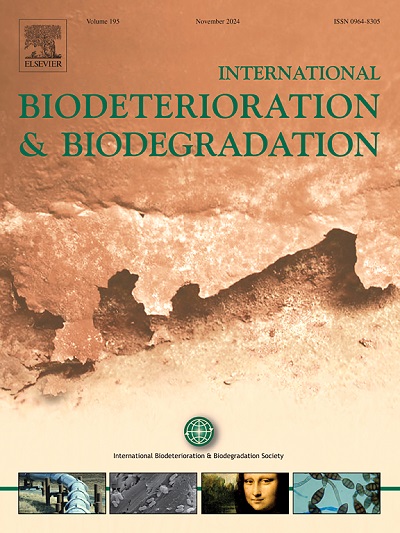Anaerobic reductive dechlorination of chlorobenzenes by an enrichment culture containing Dehalobacter species
IF 4.1
2区 环境科学与生态学
Q2 BIOTECHNOLOGY & APPLIED MICROBIOLOGY
International Biodeterioration & Biodegradation
Pub Date : 2025-03-11
DOI:10.1016/j.ibiod.2025.106062
引用次数: 0
Abstract
Chlorinated benzenes are pervasive contaminants in soil and groundwater at industrial sites globally. We previously obtained an anaerobic 1,2,4-trichlorobenzene-dechlorinating enrichment culture originated from a chemical plant. In this study, we evaluated the dehalogenation capability of this consortium to utilize all chlorobenzene congeners as the ultimate electron acceptors. Over a period of approximately 250 days’ incubation, 11 out of 12 chlorobenzene congeners were successfully dechlorinated to monochlorobenzene, suggesting that the consortium has no preferential dehalogenation pattern for flanked chlorines on the benzene ring. Distinct dechlorination pathways strongly suggested that novel dechlorinator and reductive dehalogenases prevailed in this consortium. The 16S rRNA gene amplicon sequencing revealed that the microbial communities were predominantly composed of fermenters such as Sporomusa, Desulfitobacterium and Longilinea; methanogenic Methanobacterium; and the organohalide-respiring bacterium Dehalobacter. The bottles actively engaged in chlorobenzene dechlorination harbored higher abundances of Dehalobacter species. Quantitative PCR analysis further demonstrated that Dehalobacter conserved energy from chlorobenzene dechlorination, with growth yields ranging from 1.2 × 105 to 2.27 × 107 copies per μmol of Cl− released. The versatile chlorobenzene dechlorination capacities of the consortium underscores its significant potential for remediating chlorobenzene-contaminated field sites.

含脱盐杆菌的富集培养物对氯苯的厌氧还原脱氯
氯化苯是全球工业场所土壤和地下水中普遍存在的污染物。我们以前获得的厌氧1,2,4-三氯苯脱氯富集培养起源于一个化工厂。在这项研究中,我们评估了该联盟利用所有氯苯同系物作为最终电子受体的脱卤能力。在大约250天的孵育期间,12个氯苯同系物中有11个成功地脱氯为一氯苯,这表明该联合体对苯环上的侧翼氯没有优先的脱卤模式。不同的脱氯途径强烈表明,新型脱氯剂和还原脱卤酶在该财团中占主导地位。16S rRNA基因扩增子测序结果显示,微生物群落以孢子菌(Sporomusa)、脱硫菌(Desulfitobacterium)和Longilinea等发酵菌为主;产甲烷甲烷细菌属;以及有机盐呼吸细菌脱盐杆菌。积极进行氯苯脱氯的瓶子中含有较高丰度的脱盐杆菌。定量PCR分析进一步表明,脱氯菌在氯苯脱氯过程中保存了能量,每μmol Cl -释放量为1.2 × 105 ~ 2.27 × 107个拷贝。该联合体的多功能氯苯脱氯能力强调了其在修复氯苯污染场地方面的巨大潜力。
本文章由计算机程序翻译,如有差异,请以英文原文为准。
求助全文
约1分钟内获得全文
求助全文
来源期刊
CiteScore
9.60
自引率
10.40%
发文量
107
审稿时长
21 days
期刊介绍:
International Biodeterioration and Biodegradation publishes original research papers and reviews on the biological causes of deterioration or degradation.

 求助内容:
求助内容: 应助结果提醒方式:
应助结果提醒方式:


